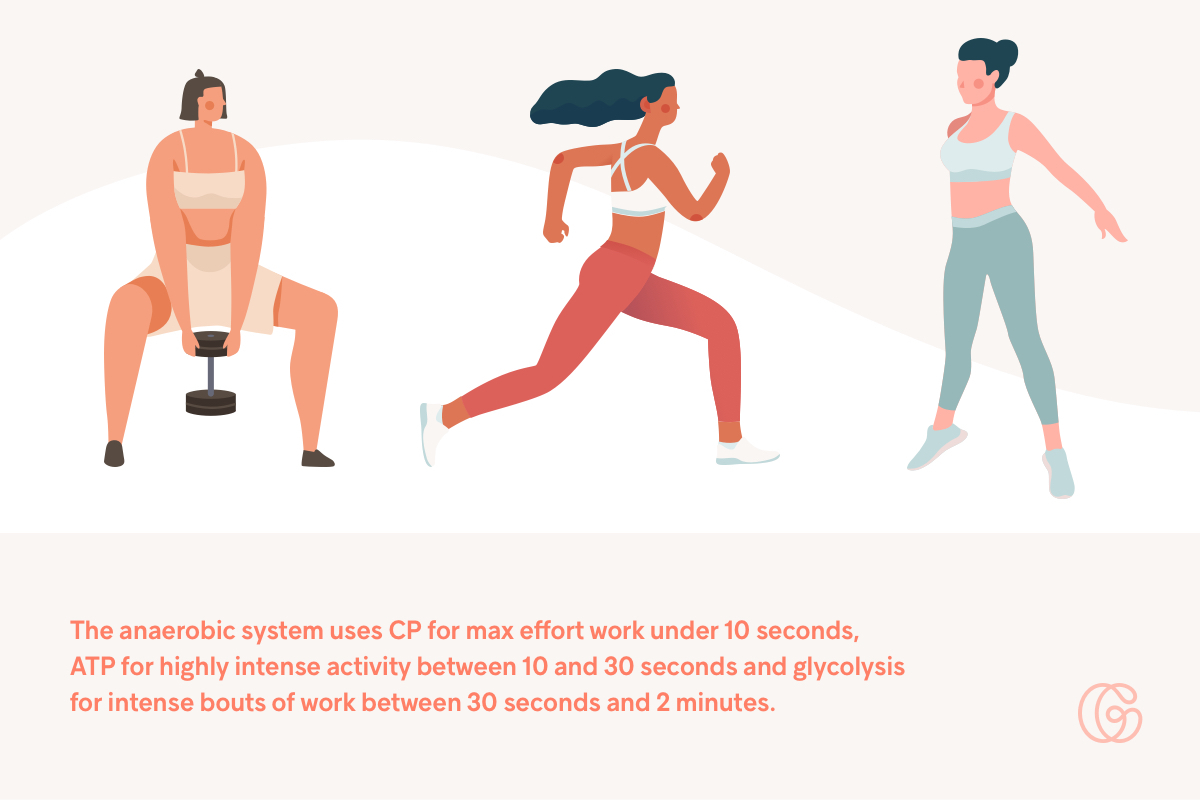
If you’re deep into fitness, you’ve probably come across the term “anaerobic.” While similar in writing and sound to “aerobic,” it’s anything but.
Unlike aerobic (cardio-based) training, which requires oxygen to move, anaerobic activities are defined as short bursts of energy that are independent of oxygen—think sprinting, jumping or heavy weight lifting.
So, what about high-intensity interval training (HIIT)? It must be anaerobic, right?
To clear up any confusion, we’ll walk you through what anaerobic exercise really is and show you how you can maximize your fitness program by adding it to your workout routine.
What’s the Difference Between Aerobic and Anaerobic Exercise?

Activities that require your body to use oxygen are considered aerobic. Aerobic activities include distance running, swimming, cycling and yoga and predominantly burn fats or carbs as energy.
Fats: If aerobic exercise is low enough in intensity (65-80% of your max heart rate) it’s mainly fueled by fat. Because fat is energy-rich—9 calories per gram compared to 4 per gram for carbs or protein—it can provide energy for longer periods of time. On the downside, it takes longer periods of time to use.
Carbohydrates: As you increase the intensity (> 85% of your max heart rate), but before it becomes extremely hard, carbohydrates are utilized as energy. Glycogen—stored carbs—is broken down in your liver or muscles through a process known as glycolysis. This only occurs when you transition to great intensities, like when you go from light jogging to running faster.
On the other hand, anaerobic activities require short bouts of energy, like lifting heavy weights or sprinting, and don’t require your body to use oxygen. You’ll tire out fast during anaerobic activities because it uses a fast-acting energy pathway called the phosphagen system. The phosphagen system uses creatine phosphate (CP) to generate adenosine triphosphate (ATP), the chemical which provides energy for all body processes.
Creatine phosphate (CP): During all-out, max effort work under 10 seconds, your body uses CP, which runs out in seconds (not minutes). Once CP runs out, it takes a long time for your body to completely restock its stores. While your body naturally contains CP, you can increase your stores by eating foods high in creatine, like red meat.
Adenosine monophosphate (AMP) and adenosine diphosphate (ADP): Your phosphagen system not only breaks down CP for all-out energy, it adds AMP to ADP to make ATP (adenosine and 3 phosphates). Once ATP has been formed, your body can break it back down again into AMP and ADP for more anaerobic energy. The anaerobic energy from this process can last up to 30 seconds.
Anaerobic glycolysis: While your body uses carbs for fuel during aerobic exercise, if you’re working out at a high intensity, only anaerobic glycolysis is utilized. Anaerobic glycolysis produces short bursts of energy during intense exercise for a period ranging from 30 seconds to 2 minutes. Any activity over 2 minutes will rely on aerobic metabolism.

The bottom line: Your anaerobic system fuels your body during intense activity lasting no more than 2 minutes. But you don’t just toggle one off or on—both systems (aerobic and anaerobic) are working at the same time. Your body simply emphasizes one over the other depending on the type of activity you’re doing and how much energy you need to do it.
The Many Benefits of Anaerobic Exercise

The main difference between anaerobic and aerobic exercise is intensity. If you’re finding it extremely difficult to breathe, you’re most likely performing anaerobic exercise.
Working out at a higher intensity is the principle behind true HIIT, which intersperses short periods of extremely intense, near-max work with longer periods of recovery.
But don’t assume your anaerobic system is being trained during all HIIT classes. Most HIIT classes are more aerobic-based, noted by short work-to-rest intervals, which give you little time to recover completely before your next bout.
Research suggests that anaerobic exercises is effective for:
- building muscle
- getting faster
- becoming more powerful and explosive
- crushing your PRs
- improving your energy levels
Not only that—it’s time-efficient. You’ll accomplish more in less time!
While you might think both systems function separately, you’ll actually improve your aerobic fitness during anaerobic activity. When you build strength, you boost your cardiovascular endurance, meaning you can go longer and harder during endurance training.
Think of it this way—they fitter your aerobic system, the harder you can work without your anaerobic system shutting down. By just adding some sprints to your workout routine, your long runs become easier over time.
The Perfect Strength Training Plan for Cardio Enthusiasts
Just to be clear, unless you’re a competitive athlete or bodybuilder, the foundation of your workout program should be focused on aerobic exercise to build cardiovascular endurance. But research indicates that adding anaerobic (oxygen-independent) exercise such as strength training to your weekly routine can increase your power output and time to exhaustion, which helps you resist fatigue for longer periods of time.
And if you think lifting weights or engaging in other “anaerobic” activities will slow you down or build too much bulk, think again!
Endurance athletes and cardio enthusiasts can reap the benefits of anaerobic exercise by performing total-body strength training 2 to 3 times per week. But strength training isn’t the only form of anaerobic conditioning you should be doing. Research suggests sprinting and interval training can increase your endurance and aerobic capacity (VO2 max), while reducing the propensity of injury.
Need some inspiration? Check out the perfect strength training workout for cardio enthusiasts. All you’ll need is a set of dumbbells and a mat or towel.
*Note: This is an aerobic strength training circuit used to get endurance enthusiasts accustomed to strength training before bumping up the intensity. Use light dumbbells (DBs) and perform the circuit for a total of 3 rounds with little to no rest between sets. At the end of each round, rest 60 seconds before repeating.
Wherever you’re at in your fitness journey, find workouts that move you in the Gymondo app. Start your free trial today and explore HIIT, strength training, cardio and more.




Kommentar schreiben